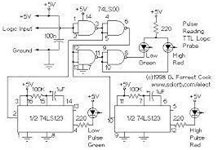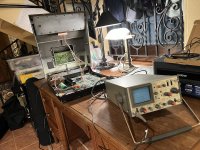Hugo Holden
Veteran Member
If you suspect a digital issue, a very handy tool for quick diagnosis and tracing is a simple logic probe. You give it power and ground and you can poke it into the circuit on IC legs and such and check if the signal is high, low, floating (nothing driving it), or fluctuating (either rapidly or pulses). They're honestly much faster to work with than an oscilloscope for certain tasks, albeit more limited, and much much cheaper. Unlike a logic analyzer there's only one channel but they're much more responsive for quick checking if signals make sense in a digital circuit.
I don't even bother with one. The data provided is severely limited. I would agree that "if it is all you have" though use it.
When I was a boy around 8 years old I could repair most transistor radios. All I had was a crystal earpiece that I could connect onto points in the audio circuit to hear the sound. Then I used the earpiece with a germanium diode and I could demodulate the audio off an RF carrier.
One day I got an analog multi-meter and I could test voltages, specifically ones across the emitter resistors of the transistor stages. That way I could determine the emitter currents of the transistors and check their DC bias conditions. I thought " I had it made" when I was about 15 years old.
Then one day as I hit about 20 years old, a friend loaned me a scope. All of a sudden I had a view into a previously concealed world of voltages changing with time. After that there was no going back.
Since then I have equiped myslf with good scopes like the Tek 2465B and I can see into circuits operating at over 400MHz.
A logic probe, by comparison, is a hopeless entity and a mere "toy". Better than nothing though, but it is nothing at all like a good scope for fault finding analog or digital circuitry.
Logic probes are useful to tell if a level is constantly low, high or has pulses.
Oddly in the area of Dynamo and Alternator voltage regulators, the power supply to the field winding (in the Dynamo case) and the Stator (in the alternator case) can at times have these three conditions.
A while back I designed a logic probe, which was very similar in its operating principles to a logic probe for Cmos or TTL circuitry, that could be used as a fault finding tool for Auto Electricians working with dynamo and alternator voltage regulators:
Last edited:




